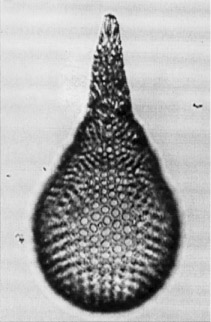 Lamptonium
sanfilippoae Foreman
Lamptonium
sanfilippoae Foreman Lamptonium
sanfilippoae Foreman
Lamptonium
sanfilippoae ForemanLamptonium sanfilippoae Foreman, 1973, p.436, pl.6, figs.15, 16, pl.11, figs.16-17
Shell of two segments, pyriform, with collar stricture not expressed externally. Cephalis subhemispherical, with a massive layer of rough shell material apically from which extends a bladed horn frequently broken. Internally the collar stricture has five collar pores, the vertical spine rising so sharply that it does not divide the cervical pore. Thorax proximally with or without one or two slight constrictions, basally closed, and tending to be flattened. Circular to subcircular pores with or without prongs on their margin may be largest medianly at point of greatest expansion and distinctly smaller, less regularly arranged basally, or more regular in size, tending to longitudinal alignment; surface spiny (Foreman, 1973).
Based on 15 specimens. Length overall, exclusive of horn, 210-325 µm; greatest width 130-205 µm (Foreman, 1973).
Large pyriform test of two segments, closed distally. Cephalis enclosed in a rough layer of shell material continuing from the horn (Riedel and Sanfilippo, 1978a).
This species is distinguished from co-occurring members of the genus Lamptonium by being two-segmented, closed basally and possessing a bladed horn covered proximally by a porous layer of shell material (Sanfilippo et al., 1985).
This large, two-segmented pyriform species exhibits all its variation in the thorax. The thorax may have one or two constrictions proximally; it is closed, and varies in shape from subspherical to terminally flattened. The thoracic pores are circular to subcircular, largest medially, with a tendency to longitudinal alignment (Sanfilippo et al., 1985).
L. sanfilippoae occurs in early Eocene assemblages from the Gulf of Mexico and the tropical Pacific. Its morphotypic first appearance lies within the Buryella clinata Zone and its morphotypic last appearance lies within the Phormocyrtis striata striata Zone.
L. sanfilippoae is obviously related to the lineage from Lamptonium pennatum to L. fabaeforme constrictum, but the details of the phylogeny are unknown. L. sanfilippoae left no descendants.